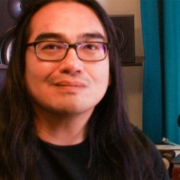Interview with Michael Begay
Building Bridges Through Music:
An interview with Michael Begay
By Gail Browne
Michael Begay is an accomplished musician and composer. He has served as a composition instructor in residency for the Grand Canyon Music Festival’s Native American Composers Apprentice Project (NACAP) for over eight years, and just finished a second residency with the South Dakota Symphony Orchestra’s Composition Academy. Both programs educate Native American high school students in the art of music composition, followed by the world premiere of created works. Michael has recently entered the composition program at Johns Hopkins Peabody Institute in Baltimore, MD.
As a young person you had broad musical interests, and you were drawn to the Native American Composers Apprentice Project at the Grand Canyon Music Festival, which focuses on western classical music. What led you to this program?
In my early high school years there weren’t any music programs available to me where I was attending school, or if there were, I was always put on the wait list to be entered into those programs. I heard there was a classical guitar program opening up at Greyhills Academy in Tuba City, so I thought I’d move back to the Navajo reservation and attend that class. I enrolled and then the class got cancelled. So I was stuck on the Navajo Nation in a school with no guitar program. Luckily the school librarian was the retired percussionist for orchestra. He helped me early on find Paganini, Mozart, Beethoven, and I tried to adapt their music to guitar. Knowing no theory at the time, I tried to figure stuff out by myself. This is the late 1990s and early 2000s. The Internet was still young and there weren’t many instructional videos.
The librarian frequented the Grand Canyon Music Festival. In early 2001 the Festival launched the Native American Composers Apprentice Project (NACAP) with composer Brent Michael Davids and Clare Hoffman, Festival co-founder. I was invited to participate. There were just five of us in the first group. Now we have over 20 students for every year.
As a student I looked forward to it every year. Living on the Navajo Nation everything is 100 miles away in any direction. Accessibility is challenging. You have to make the best of what you have. I did get exposure to the outside world from my parents, but not having the access that living in a city offers can be difficult. Now with the Internet and the digital frontier it’s easier, but you also have to be concerned about what you feed your mind.
I run a radio station, and I feel it’s my responsibility to offer quality world music to my community. I feel strongly that giving that exposure to people at a young age is crucial to their understanding of the larger world and knowing that they can make a contribution to it.
Speaking of radio, you produce a podcast called Original Score in association with the Grand Canyon Music Festival. What are you hoping to achieve with that project?
One of the main things I like about the show is that I get to give the stage to the NACAP students. During the concert performance at the Grand Canyon you’re only allowed to introduce yourself and say a few sentences about your composition since there are 20 plus pieces to get through in one day. With this platform they have a chance to speak a lot more about their work, their art, their story, their narrative. On top of that, the listener almost gets to experience what I experience as a composition teacher. I get to listen to their composition from the first note, from inspiration to fruition. I get to hear what their ideas are and what they’re going through as young people. That’s what I really like to capture on the show and present to the audience— the story behind the composition. NACAP doesn’t just focus on western classical music. NACAP uses the tools of western classical music but not necessarily all the rules; students can build their own composition out of the tools we show them.
There’s also an exchange of cultures because students are working with a quartet trained in classical music. And then you have the students who live on the different indigenous nations and been brought up differently from the musicians. When students meet musicians for the first time it’s powerful. Students get to see things outside of their world and the musicians get to engage with the students and Grand Canyon landscape. It’s humbling for them.
You’ve said that music supports story/narrative in your compositions. Can you describe how this works?
I don’t just like to give the composition away insofar as it’s just black and white notes on the paper that the musician knows how to play. I like to compose with deeper meanings embedded in the whole composition. I try to find artistic elements to hide inside each composition. Oftentimes weavers in Navajo tradition leave a mistake in their work so they’re not trapped in it, or so there’s a way out of it. I usually put things in my compositions in the same way.
Like with my mini-opera, Great Gambler: this piece is eight minutes long and deals with the sun deity. Eight minutes is how long it takes for sunlight to reach the earth, so my whole composition takes place within that time of sunlight travel. When the piece is done only one photon has traveled through existence.
Fortunately I can talk about these things with the musicians, so they know they’re not just playing notes on a page but need to look for the deeper meaning, as if it’s type of a ritual or ceremony.
You’ve been commissioned to write a Christmas carol for Trinity Cathedral’s centennial year celebrations. What is it like for you writing in Christian context?
This piece has been interesting to write and rather challenging as well. It will be my third work for voice. One of the main things I’m trying to do with this carol is to find the parallel or commonality between the Christian and Navajo traditions. I’ve been talking with elders to find the old stories that aren’t necessarily in the books. I could easily go to the Diné College library, but I want to hear it from the oral tradition, from multiple sources. This piece is about finding that commonality and highlighting it. That’s what breaking down walls is for. Finding what’s different is easy but finding what’s common is difficult.
COVID has made this work more remote. I’m looking at alternative means of getting interviews. Sometimes the elders don’t speak English, so translation is a part of the process. It’s challenging but rewarding.
For the music I’m thinking about harmonies, chords and progressions. The intervals will have meaning; it could be in the harmonics or the line where something is hidden. There might be a reason why I’m choosing this or that chord progression. The story is still being put together, so on this one I’m working backwards. I’m getting the narrative and subject matter together first, and then I’ll write the music and work on the hidden gems inside.
What else are you working on now?
I just finished a new composition with a couple of my colleagues from the South Dakota Composition program for the Metropolis Ensemble. It’s called a biophony, a living composition. I collaborated with Jeff Paul who is the principal oboist for the South Dakota Symphony Orchestra and Theodore Wiprud, another composer and head of the Music Composition Academy. It’s a piece that can be for any number of players. It’s very flowing and free and is supposed to be played in the green parts of New York City.
I’m also finishing up orchestra arrangements for two of my older works, both string quartets, with the Orchestra of Northern Arizona. Also, I’m working on two cello commissions from the Boston Conservatory—a quartet and an octet.
As you begin your studies at the Peabody Institute at Johns Hopkins what are you hoping to gain from this experience?
I’m looking forward to learning what I haven’t even fathomed yet in composition. I feel like I need to do this because the world is so divided nowadays. You have to wonder: what am I going to do with this knowledge? I think one of the greatest services I can take on as an artist is to build bridges to cultures and to peoples through music and art and to learn from the diversity of people I haven’t yet had the opportunity to meet and experience.
I want to bring the knowledge back home to our people and show the young people that their dreams are possible. If you work hard, and put your mind to it, then everything is within your reach. You have to want something bad enough to learn about it, to discipline yourself, and put your life force and energy into it.
I always think about what I can do to facilitate that, to show young people they can do it. That it is possible.
Reprinted from the Journal of the Association of Anglican Musicians (Vol. 30, No. 9, November 2021) with permission.


